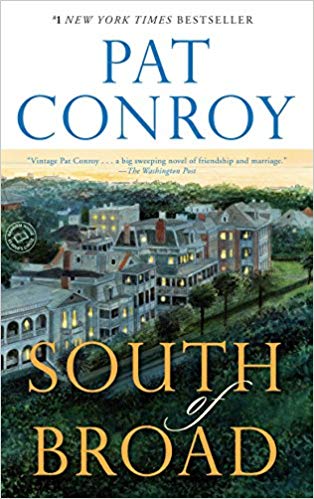Pete’s Pick
March, 2019
South of Broad
Pat Conroy
Published by Doubleday, 2009
This is one of several great novels written by Pat Conroy, who writes with great passion about the South. This novel takes us on an intense inside look at one of the great Southern cities, Charleston, SC. The focus of the novel is following ten young people entering their senior year of high school and growing into adulthood during the mid-1970’s and 1980’s. The setting is the area of Charleston known as South of Broad—the area with all the aristocratic mansions for which Charleston is famous.
Author
Pat Conroy grew up as one of seven children of a U.S. Marine Corps officer and lived on a number of military bases throughout the South. After attending the Citadel in Charleston, he taught high school English and Pyschology in Beaufort, SC. In 1969, he took a job teaching underprivileged kids in a one-room school house on Daufuskie Island near Hilton Head Island in South Carolina. He was let go from this teaching position after one year because of what the school system characterized as unconventional teaching methods and his refusal to allow corporal punishment of his students. He wrote about his experiences that year in a memoir called The Water is Wide, which became a major motion picture. He then continued writing as a career and has written a number of novels which made it to the big screen. He passed away in 2016 as the result of pancreatic cancer. He is reknown for his lyrical style of writing and for storytelling in a way that is very captivating. In my opinion, he has a unique way of looking inside the human experience and is able to put it to words in a way that allows us to really experience what the characters are experiencing.
Story
The setting for this novel is Charleston, South Carolina from 1969 through 1990. In specific, the focus is on the area of Charleston known as South of Broad, which is where all the aristocratic mansions are located—the ones for which Charleston is famous. The story follows 10 students who are entering their senior year of high school. The narrator of the story, Leopold Bloom King, is the son of the Peninsula High School principal, Dr. Lindsay King, and one of the science teachers at the high school, Jasper King. The story follows Leo and nine other high school seniors he meets the first day of school as they go through that last year of high school. Four of the seniors are black and are experiencing their first time attending a predominately white high school. By the same token, this is the first year Peninsula High has had black students as part of the student body. Two of these new students are orphans who have just arrived at and are living at a nearby orphanage.
The story follows these 10 students through the eyes of Leo as they experience the tensions of racial integration, raging hormones as teenagers, and the tension that exists between those from the aristocratic society and those from the working class part of society. We follow the guys as they are members of the school football team which for the first time has a black coach and the gals as they make up part of the cheerleading squad. We also get introduced to the world of homosexuality as Trevor begins to act out his attraction for same-sex relationships.
The story skips over college years and takes us into the late 70’s and early 80’s as the friends have entered their careers in law, writing, acting, music, and home making. We experience the tensions of social status and loose morals and the beginnings of the AIDS epidemic. We get to witness how the experiences of that senior high school year have provided a foundation for the friendships and relationships that exist 20 years later. This foundation becomes extremely important as Trevor is known to have developed AIDS but goes missing in San Francisco, and the friends respond to his twin sister Sheba’s plea to help her find Trevor. As the story makes its way to its conclusion, we get to experience Hurricane Hugo in 1989 as it clobbers Charleston and these friends are thrown together to survive the storm and its aftermath. The bittersweet conclusion takes us through the deep despair and horror of tragic loss of life and its aftermath, but ultimately leaves us with the hope that through the human experience we can find hope, support, and love to see us through our years.
Evaluation
I love reading Pat Conroy’s novels because of the unique way he has painting word pictures while telling a compelling story. The way he creates his sentences and paragraphs absolutely draws me in to the story and it literally plays out in my mind as I read. I’m right there with the characters experiencing what they are experiencing. It was also wonderful following the story in Charleston, which is a city where my wife and I spend Thanksgiving every year on our way home from our annual vacation in Hilton Head. If you love words, you’ll love Pat Conroy. If you’ve ever diagrammed sentences in English class, his novels will give you an amazing challenge. The reading is vigorous. It’s like a movie going on in your head. It’s intense. And it’s heart wrenching. I loved it.
